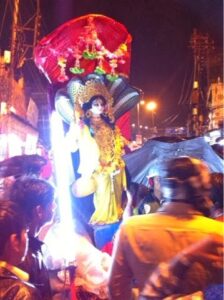I have recalled that I have a small thing to be done for the blog. Early last year I visited Kumbh Mela and I promised I would express my opinion concerning the symbolism of this holiday, but I was tied up with my affairs and I have not written a corresponding port. But I will do it now.

So, according to the legend the festival of Kumbh Mela is associated with a story that tells that Garuda had spilled some drops (mela) from the bowl (kumbha) with amrita stolen from Gods. The major portion of the amrita was spilled in the place where the Ganges meets the Yamuna (Prayaga), thus one’s bathing in this place during a holiday is favourable.
Yet my observations of this festival make me assume other origin, basic core and ritual logic of the process. I shall tell the basic facts.
- Common Hindus really come to Kumbh Mela to make the ablution. But the culmination point of the feast is the so called ceremony of Naga-sadhu-puja. The name of the ceremony is translated as “the puja of naked ascetics” but this translation is spin out of thin air since “naga” in Sanskrit means “snake”; thus, though the ascetics are really naked, it would be still more appropriate to talk about the “puja of the serpentine ascetics”. Formally the ceremony looks like the following: a crowd of ascetics in the state of trance make the ablution in the Ganges, they are sprinkled with ashes and then, walking along a special route (cordoned off and guarded), they proceed slowly in a circle that is 5 km long. After this they once again go into the Ganges for an ablution. Visually it reminds a hug serpent crawling out of the river and coming back there. Almost all participants are in the state of strong drug haze so that this snake bubbles and roars.
- The next day after Naga-sadhu-puja, this time in Varanasi, they perform a ceremony of drowning a Goddess. Richly adorned statues of Saraswati that had been for several days before used to decorate the city quarters are taken to the Ganges (here, the majority of those doing it are the adolescents who are, once again, almost drug-hazed), loaded onto a boat and are thrown down to the river through a purposefully drawn rope. They were throwing the statues all night long and I had a feeling that special delegations were bringing them from very distant parts of India.
- It is in Prayaga that one of very few temples dedicated to nagas is situated. Of course, it is an underground one.
- Some statues there had a serpent overhanging a goddess that is in fact not that characteristic for the iconography of this very goddess. In general it all looks like in old days it was not a substitute statue but a real girl who was thrown into the river as a sacrifice.
- The festival is held once in 12 years. It is approximately with the same rate that in Nepal (and, probably, in ancient India as well) the living goddess Kumari is “renewed”. Today she receives money on her education and dowry. But if we remember Frazer we will have grounds to assume that she was offered up as a sacrifice. By the way, the distance between Nepal and Prayaga is only 400 km.
- Prayaga is considered by the Hindus to be the place where the three rivers – Ganges, Yamuna and Saraswati (!) – meet (the triveni), though in fact there are only two of them. The river Saraswati runs in Pakistan!! The Hindus have explained to me that Saraswati meets this place as a “heavenly river”.
- I no way the holidays held (neither Kumbha Mela nor that drowning of the statues) way have affected carrying out the evening ceremony of Ganga Aarti in Varanasi; moreover, they were obviously impeding each other. Usually the festivals in scope of one religion are coordinated with each other, and following this logic the ceremony of aarti should have been modified in some way during the period when Mela takes place.
- The time of the festival coincides with commencement of field works in cold parts of India.
- In the majority of early cultures the river is correlated with the image of a Serpent. The serpent that embodies a male, a chtonian element. That is why only men take part in the naga-sadhu-ceremony, and only those doped. Unlike the Goddess of the heaven that starting from lithic age comes as a female. By the way, the vahana of Saraswati is a bird (a swan or a goose) that shows her simultaneous heavenly and aquatic nature.
Summing up the aforesaid I have come to the following conclusions:
- The festival of Kumbh Mela is very archaic and perhaps it can be traced back yet to proto-Arian times. That is why it is not coordinated with aarti that is purely Vedic in its spirit.
- In fact, Kumbh Mela is a ritual of worshipping a river in form of a serpent by means of its symbolic performing and by offering it virgins as a sacrifice. The ritual that has been in symbolic way described in a number of myths and fairy-tales of different peoples that in fact comes as a cultural universal. Probably this ritual and the myth associated with it precede the later myth of dragon-slaying.
